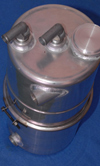The swirl tank
 The advantages of a good dry-sump system over that of a good wet-sump design in a race engine can be broadly stated as those of installation and oil control. The low-line sump pan in the dry-sump installation enables a significantly lower crankshaft centre line and the ability to control the movement of the oil to avoid 'surge' when accelerating, braking or cornering.
The advantages of a good dry-sump system over that of a good wet-sump design in a race engine can be broadly stated as those of installation and oil control. The low-line sump pan in the dry-sump installation enables a significantly lower crankshaft centre line and the ability to control the movement of the oil to avoid 'surge' when accelerating, braking or cornering.
Once we have removed the oil from the engine, however, one disadvantage is getting back into a state whereby we can introduce back to the engine. Filtering and cooling the oil are relatively simple, but removing the air and gaseous products of combustion takes a little more consideration.
When flowing through the bearings, the engine lubrication oil is subjected to a high degree of shear. As it leaks out of the bearings, the constant thrashing it receives from the pistons, con rods and crankshaft increases its overall surface area and mixes it up with the gaseous mixture that resides in the crankcase with it.
Depending on the age of the oil and the amount of agitation received, the resulting foamy mixture can take the form of whipped dirty light-brown cream. With a volume greater than that of the oil that was pumped into the engine, and which appears to flow not quite so readily as the base oil it replaces, the mixture can be difficult to handle.
In a wet-sump engine this mixture is left to settle out as best it can. The gas contained within it is held in the form of small bubbles by the action of the surface tension of the oil. These bubbles have to coalesce into larger bubbles and then into yet even larger ones before finally separating out into gas and oil.
Under the conditions prevalent in the average engine sump, this is a time-dependent exercise according to parameters such as the temperature and the viscosity (and hence surface tension) of the oil. Manufacturers of wet-sump engines assist this process by providing a gently sloping shelf underneath a significant area of the crankcase to slow down the movement of the mixture and allow time for the components to separate before it falls into the well of the sump. By picking up the oil towards the bottom of this well, enough time has elapsed for most of the gas to separate, and the oil is ready to be pumped through into the bearings again.
In dry-sump engines, the churning of the scavenge pump(s) is likely to increase the amount of gas entrainment into the oil, so it is even more important to separate the two. Once scavenged, the oil is pumped into a cylindrical tank such that the angle of incidence imparts a circular swirling action of the oil within it.
The size of the entry pipe and the volume of flow rate through it (the tank) and its diameter are such as to act like a centrifuge, with the air-gas mixture moving towards the centre while the oil keeps to the outside. Picked up again at the base in its de-aerated form and pumped through a cooler and a filter, the oil can be directed back towards the engine again. Since the total volume of oil in a dry-sump system will almost always be greater than that in a wet sump, and assuming the bearing flow rates between a wet- and dry-sump engine are the same, the greater volume of oil in the dry-sump system will allow even more time for the oil and gas to separate.
A dry-sump oil system containing more oil than a wet-sump equivalent? That seems a bit of a paradox to me.
Fig. 1 - Dry-sump tank showing the position and angle of incidence of the oil intake
Written by John Coxon